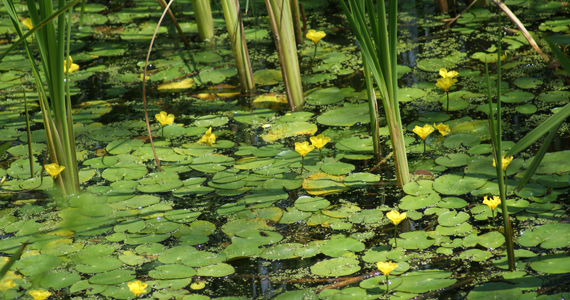The vegetation is the basis of life, providing shelter, protection and nourishment for organisms, while the roots of the plants provide soil stabilization and retention. Furthermore, the vegetation enriches the landscape, improves the microclimate and reduces the air and noise pollution. All species contribute to the balance of a unique ecosystem. More specifically, the lake is characterized by a rich flora (114 taxa) and hosts many aquatic (62 taxa) and hygrophilous macrophytes (31 taxa).
Pamvotis Lake belongs to eutrophic lakes (vegetation type Magnopotamion or Hydrocharition). Among the lake’s vegetation can be found floating aquatic plants like duckweeds (Lemna sp.), pondweeds (Potamogeton sp.), water lilies (Nymphaea albae), iris (Iris pseudacorus) etc. Species with limited distribution in Greece are present too, such as water fern (Azolla filiculoides) and the common water-starwort (Callitriche stagnalis). The shoreline of the lake and the island are covered by dense and extensive reed beds (Phragmites sp.). The riparian vegetation also contains remains of hydrophilic forests of willow, poplar and plane tree (Salix sp., Populus sp. and Platanus sp.), as well as limited wet meadows periodically flooded during winter. The latter are of particular importance, because they serve as nesting and feeding ground for aquatic birds.
The Island also has undergone reforestation with black pines (Pinus nigra), while the Eastern part of the lake is an agricultural area.
In the outer zone of the Lake up to the mountain Mitsikeli, there can be found maquis/ shrubland with juniper (Juniperus oxycedrus), Greek Quercus spp. forests, pseudo maquis, Garrigue or phrygana, heathland with spinous bushes and pseudo-steppe with grasses and therophytes. In the wider area of the basin, including the mountain Mitsikeli, plant species characterized as rare, threatened or endemic can be found.
The human activities that during the years put pressure on the habitats and consequently on the flora, are summarized below:
a) Land clearing of the riparian vegetation, causing a quantitative reduction in the area of the riparian plant communities.
b) Drying of the Lapsista lake and creation of a dike, causing the loss of the periodically flooded wet meadows and shallow areas of the lake.
c) Disruption of the water balance and the pollution (urban waste, livestock waste, fertilizers and pesticides from agricultural crops), which resulted in eutrophic conditions and the expansion of reeds, which gradually cover the lake’s open areas, and change the structure of the aquatic plant communities.


